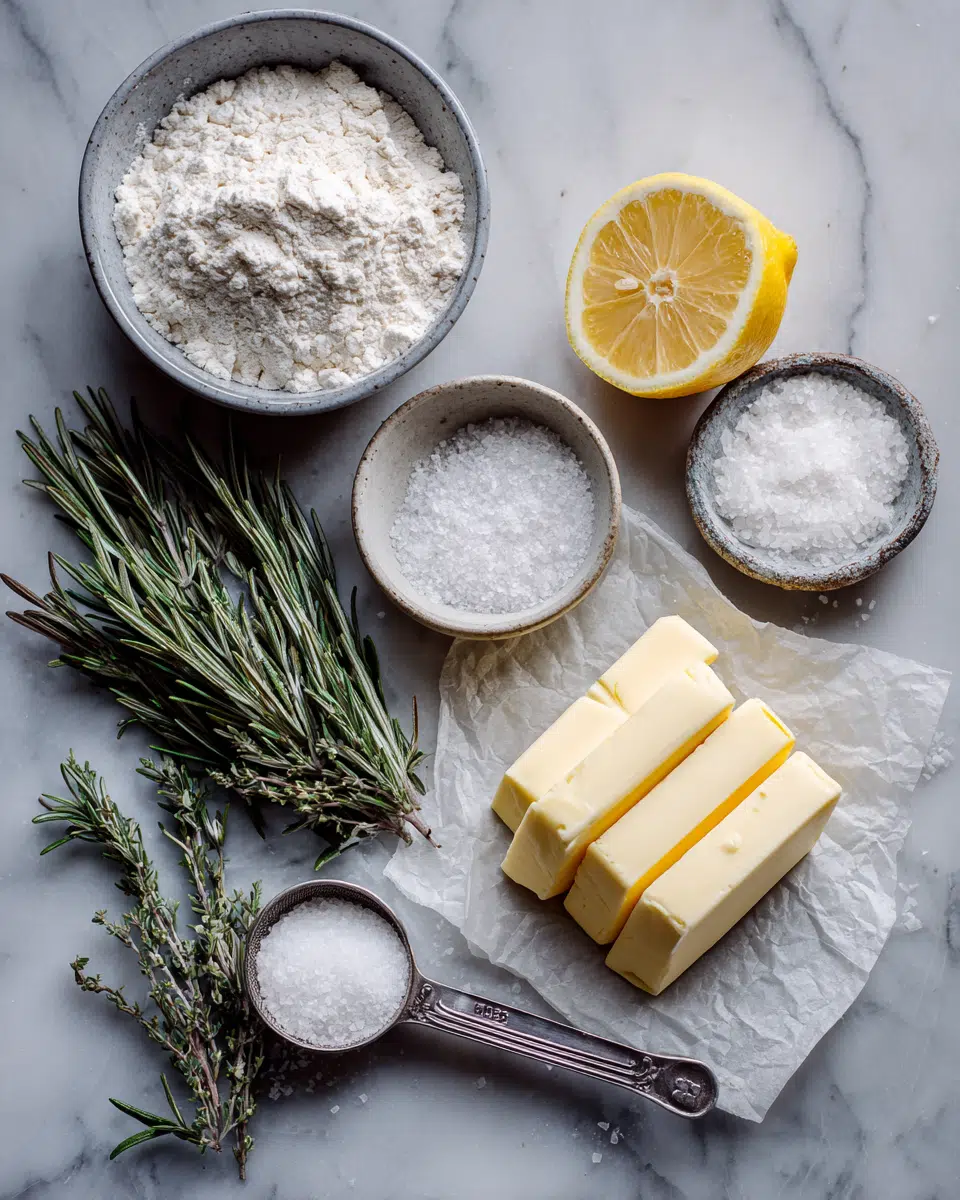

Table of Contents
There’s something magical about the combination of citrus and herbs—especially when wrapped in butter. That’s what makes rosemary-lemon shortbread so irresistible. It’s not your average cookie. It’s rich, crumbly, and packed with the brightness of lemon zest and the piney depth of rosemary. This isn’t just a treat—it’s a conversation starter. Whether you’re baking a batch for holiday gifting or a cozy Sunday tea, this recipe adds something special to your table. In this article, I’ll share how this cookie came to life in my kitchen, plus expert tips, variations, and answers to the most common shortbread questions.
The Story & Flavor Behind Rosemary-Lemon Shortbread
A Cozy Memory Behind the Cookies
I still remember the day I stumbled into the flavor combo that inspired this cookie. It was a warm spring afternoon, and I had just returned from the local market with a bag full of lemons and a small rosemary plant tucked under my arm. The kitchen smelled like sun and soil, and I was in the mood for baking—but not something overly sweet.
That’s when the idea sparked. I pulled out my basic shortbread formula and grated fresh lemon zest into the dough. Then I snipped a few rosemary sprigs, chopped them fine, and tossed them in. What came out of the oven 30 minutes later was golden, fragrant, and unlike any cookie I’d ever baked.
Since that day, rosemary-lemon shortbread has become a signature in my home, right alongside favorites like my Lemon Cookie Recipe and Crumbl Cookie Recipe.
Why Rosemary and Lemon Make the Perfect Pair
Lemon brings a bright, zesty pop that lightens the buttery richness of shortbread. Rosemary, with its earthy and slightly floral notes, cuts through sweetness and adds unexpected depth. Together, they elevate a humble cookie into something elegant and unique.
This pairing feels both rustic and refined—perfect with tea, wine, or even cheese. It’s these simple contrasts that make rosemary-lemon shortbread a recipe worth repeating all year long.
Baking the Perfect Rosemary-Lemon Shortbread Base
The Golden Ratio: What Is the 3-2-1 Rule for Shortbread?
Great shortbread always starts with a simple rule: the 3-2-1 ratio—three parts flour, two parts butter, and one part sugar. This classic structure gives you that perfectly crumbly texture with rich, buttery flavor and just the right amount of sweetness.
Here’s how that looks in practice:
- 1½ cups flour
- 1 cup unsalted butter (softened)
- ½ cup granulated sugar
This formula is reliable and easy to scale up or down depending on your batch size. In this rosemary-lemon shortbread recipe, you follow the same base but elevate it with flavor: fresh lemon zest and finely chopped rosemary bring brightness and depth to every bite without affecting the structure.
This base is your blank canvas—and once you’ve mastered it, you can easily experiment with flavors like lavender, thyme, or citrus blends.
Common Mistakes When Making Shortbread
Shortbread may be simple, but it’s easy to take a wrong turn if you’re not careful. Here are the most common issues bakers face—and how to steer clear of them:
- Cold butter: If your butter isn’t soft, it won’t cream properly with the sugar. This can lead to a dense, uneven texture.
- Overmixing: Once you add the flour, mix just until the dough holds together. Overworking it activates gluten and makes the cookie tough.
- Skipping the chill time: Letting your dough chill before baking helps the cookies hold their shape and improves the final texture.
- Baking too long: Shortbread should be pale golden, not browned. Pull them when the edges are just beginning to color.
Using room temperature ingredients, a light touch, and precise timing helps you create that signature melt-in-your-mouth texture that defines perfect shortbread.
The Signature Touch – Lemon Zest, Rosemary & Salted Glaze
How to Infuse the Dough with Citrus & Herb Flavor
The beauty of rosemary-lemon shortbread lies in how two simple ingredients—zest and herbs—completely transform a basic dough. But it’s all about when and how you add them.
Always zest your lemon directly over the bowl. This releases the citrus oils right into the dough, locking in that vibrant aroma. Use a fine grater or microplane and zest only the bright yellow part—avoid the bitter white pith. One medium lemon provides all the zest you’ll need.
For the rosemary, use fresh sprigs if possible. Strip the leaves and chop them very finely—no one wants a mouthful of tough leaves. Add the rosemary at the same time as the sugar and butter so its flavor infuses as the base mixes. This softens its intensity and keeps the overall cookie balanced.
The combination of bright lemon and earthy rosemary makes this shortbread feel sophisticated, but still approachable—perfect for everyday baking or small celebrations.


The Salted Glaze Twist: Why It Works
Here’s where this recipe takes a delicious turn—a salted lemon glaze. It’s a subtle, savory-sweet topping that elevates every bite.
To make it, whisk together:
- ½ cup powdered sugar
- 1 tablespoon lemon juice
- Pinch of flaky sea salt
Drizzle it over the cooled shortbread and let it set. The salt enhances the lemon and cuts through the richness of the cookie. It also adds a delicate crunch when you bite in.
Want to get creative? Add a touch of vanilla extract or cracked pink peppercorn to the glaze for an extra layer of surprise.
This glaze finishes your rosemary-lemon shortbread with elegance—and turns a simple cookie into something gift-worthy.
Storage, Gifting & Serving Ideas for Rosemary-Lemon Shortbread
How Long Do Shortbread Cookies Stay Fresh?
One of the best things about rosemary-lemon shortbread—aside from how incredible it tastes—is how well it keeps. These cookies have a low moisture content, which means they hold up beautifully when stored the right way.
Here’s how to keep them fresh:
- Room temperature: Store in an airtight container for up to 7–10 days. Keep them in a cool, dry spot away from sunlight.
- Refrigerator: Not necessary unless your glaze contains cream (this one doesn’t), but can extend freshness slightly.
- Freezer: Freeze unglazed cookies for up to 3 months. Separate layers with parchment paper. Thaw at room temperature and glaze just before serving.
Glazed cookies can also be frozen, but the texture of the glaze may change slightly. For best results, add the glaze after thawing.
This means you can bake ahead for holidays or events and still enjoy that crisp, buttery texture days later.
Creative Ways to Serve and Gift These Cookies
Rosemary-lemon shortbread is one of those treats that works in any setting. Here are a few creative ways to enjoy or gift them:
- Tea time treat: Serve with black tea or an herbal blend like chamomile or mint.
- Holiday cookie box: Add to your gift lineup with other herbaceous bakes or citrus-forward cookies.
- Savory board addition: Pair with mild cheeses like brie or goat cheese as a sweet-savory element.
- Wedding or shower favor: Stack in clear bags or tins with a rosemary sprig and custom label.
The elegant flavor profile makes them feel special, while the simplicity of the ingredients keeps them grounded. They’re a go-to when you want to impress without stress.


Frequently Asked Questions About Rosemary-Lemon Shortbread
What is the 3-2-1 rule for shortbread?
The 3-2-1 rule refers to the classic shortbread ratio: 3 parts flour, 2 parts butter, and 1 part sugar. This simple formula ensures a tender, crumbly texture and is the foundation of traditional shortbread. It allows for easy scaling and is perfect for experimenting with flavors like lemon zest or rosemary.
What are the mistakes when making shortbread?
Common shortbread mistakes include using cold butter, overmixing the dough, skipping the chill step before baking, and overbaking. Each of these can lead to tough, dry, or misshapen cookies. Always use softened butter, mix gently, and bake just until the edges are lightly golden.
How long will shortbread cookies stay fresh?
Shortbread cookies stay fresh for 7–10 days at room temperature when stored in an airtight container. Unglazed cookies can be frozen for up to 3 months. Glazed cookies can be frozen as well, but it’s best to add the glaze after thawing for a clean finish.
What is the secret to good shortbread?
The secret lies in simplicity: quality ingredients, correct ratios, and gentle handling. Softened unsalted butter, fine sugar, and all-purpose flour form the base. Adding flavors like fresh herbs or zest gives personality. Don’t skip the chilling step—it helps the cookies hold their shape and intensifies flavor.
Conclusion
Rosemary-lemon shortbread is a buttery, zesty twist on a timeless classic. The balance of fragrant rosemary, vibrant citrus, and a whisper of salt in the glaze makes each bite feel fresh and elevated. Whether you’re baking for the holidays, gifting to friends, or treating yourself, this recipe brings warmth and flavor with very little effort.
With a reliable dough base and a few fragrant ingredients, you’ll turn a simple shortbread into a standout cookie everyone remembers.
Want more recipes & inspo? Follow me on Facebook and save your favorites on Pinterest!
Rosemary-Lemon Shortbread: Buttery, Zesty Cookies with a Salty-Sweet Glaze
- Total Time: 35 minutes
- Yield: 18 cookies
- Diet: Vegetarian
Description
A buttery shortbread cookie infused with lemon zest and fresh rosemary, finished with a light salted lemon glaze. This zesty twist brings elegance to a traditional cookie favorite.
Ingredients
1½ cups all-purpose flour
1 cup unsalted butter, softened
½ cup granulated sugar
1 tablespoon fresh lemon zest
1 tablespoon finely chopped fresh rosemary
½ teaspoon vanilla extract (optional)
Pinch of salt
For the Salted Lemon Glaze:
½ cup powdered sugar
1 tablespoon fresh lemon juice
Pinch of flaky sea salt
Instructions
1. Preheat the oven to 325°F (160°C). Line a baking sheet with parchment paper.
2. In a bowl, cream the butter and sugar until light and fluffy.
3. Add the lemon zest, chopped rosemary, vanilla (if using), and a pinch of salt. Mix to combine.
4. Add flour and mix just until the dough comes together. Do not overmix.
5. Press the dough into a rectangle about ½ inch thick. Chill for 15 minutes.
6. Cut into desired shapes and place on prepared baking sheet.
7. Bake for 18–22 minutes, or until the edges are lightly golden.
8. Cool completely on a wire rack.
9. Whisk together glaze ingredients until smooth.
10. Drizzle glaze over cooled cookies and allow to set before serving.
Notes
Use fresh lemon zest and rosemary for best flavor.
Chill the dough before cutting to help cookies hold their shape.
You can freeze unglazed cookies for up to 3 months.
- Prep Time: 15 minutes
- Cook Time: 20 minutes
- Category: Dessert
- Method: Baking
- Cuisine: American
